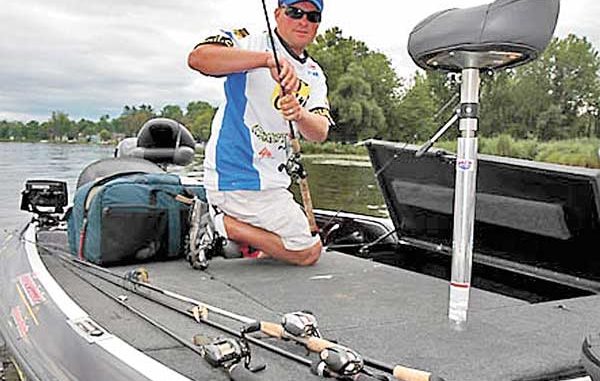
For a bass fisherman, the right rod and reel is as important as the correct lure or line. Personal preference is involved, but there are some general rules to follow when selecting the best equipment for the job at hand.
Basically, there are two types of anglers: simple and complex. An angler who keeps it simple can get by with just a few rods and be happy. Bassaholics like myself think there is a perfect rod for each bait, so we have many more rods.
There are benefits to both methods. Keeping it simple takes less thought; you can concentrate more on finding fish, which is arguably the most important thing. Getting the perfect rod and reel for each bait might get you more of the fish that bite into the boat and might make you a better caster, but it could also distract you. My advice is to start simple; as years pass, you will discover the benefits of multiple actions and lengths of rod and different gear ratios on reels. That’s what I did.
I started fishing as a youngster with a 6-foot, medium-action spinning rod. It was easy to use, and I didn’t have to worry about backlashing. I caught lots of bass on that rod, fishing a Texas-rig 7½-inch Culprit worm in fire- and-ice color.
After a year or so, I realized I could not get big fish out of heavy cover with that rod, so I bought a flipping stick and 6.3-to-1 gear ratio Daiwa baitcaster. I thought I was so cool riding my bike to the lake with my new flipping stick. Denny Brauer had nothing on me.
When I made that first cast, the line billowed up six inches above the reel, which sent me peddling home with my head down. I returned with more line and was much less cocky about the whole Denny Brauer thing.
I took it slow. For two years, I had a 6-foot spinning rod and a flipping stick. Then, I then realized I could not throw a spinnerbait very well on either of my rods, so I bought a medium-heavy 7-foot baitcasting rod and another Daiwa reel identical to the one on my flipping stick. These rods satisfied me for about a week before I decided I needed a crankbait rod. So, I bought a fiberglass 7-footer and a 5.1-to-1 reel.
I was really in business — four rods with four different actions that could handle almost anything bass fishing could throw at me. To this day, if I had to choose four rods, they’d carry those actions: a medium-action spinning rod, a flipping stick, a medium-heavy spinnerbait rod, and a 7-foot crankbait rod.
Technology is so advanced, you can dial in rods for each bait. I’ve got four different actions of crankbait rods, two jerkbait rods, two topwater rods, three different flipping sticks, medium-heavy and heavy 7-footers, a frog rod, three spinning rods with different actions and so on. Equipment that is very technique-specific has real advantages for the serious fisherman.
If you are just starting out in bass fishing or have been fishing forever, I would recommend these rods and reels:
• A 6-foot-6 medium-action spinning rod with a Daiwa 2500 size reel for finesse fishing.
• A 7-foot medium-heavy action baitcasting rod with 6.3-to-1 gear-ratio reel for spinnerbaits or buzzbaits.
• A 7-foot-6 heavy-action flipping rod with 7.1-to-1 reel for fishing jigs, worms and swim baits in heavy cover.
• A 7-foot, mediump-action crankbait rod with 6.3-to-1 reel for crankbaits and big topwaters.
• A 6-foot or 6-foot-6 medium- action baitcasting rod with 6.3-to-1 reel for topwater baits, jerkbaits and small crankbaits.
• A 7-foot heavy-action baitcasting rod with 7.1-to-1 reel for frogs, big worms and casting football or heavy jigs.
I see some big mistakes regularly: I often see anglers fishing the rods with actions that are too soft for the baits they are throwing. In my mind, you are better off being a little heavy than a little light. If you can’t set the hook, you can’t catch the bass. The only reason you would choose a soft rod is if your hooks are really small or light wire. Small hooks can be ripped out of a fish’s mouth with a heavy-action rod, and light wire hooks can be straightened out. Braided line or fluorocarbon that don’t stretch much can compensate for soft rods, but as a general rule, you are better off a little heavy.
The question I most often receive about rods is: “If you only had one what would it be?” I would choose a 7-foot, medium-heavy casting rod and 6.3-to-1 reel — you can do almost anything with this combo, but it will not be with perfection.
Dustin Wilks is a 31-year-old professional bass fisherman and Raleigh native now living in Rocky Mount. He has qualified for the Bassmaster Classic five times and operates Fish Like a Pro Fishing Lessons (www.fishlikeapro.com ). His sponsors include Skeeter Boats, Yamaha, Daiwa, Culprit, RJA Custom Crankbaits, Extreme Glove and Costa Del Mar.



Be the first to comment